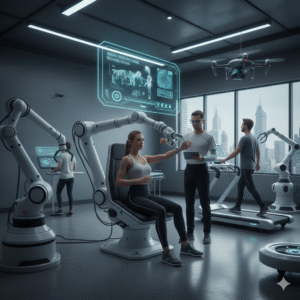
In recent years, the world of physiotherapy has transformed significantly. Among the most revolutionary changes are the advancements in Artificial Intelligence (AI) and robotic technologies. These innovations are reshaping rehabilitation—making treatments more personalized, efficient, and effective than ever before.
Whether it’s helping stroke patients relearn movements or assisting individuals with mobility challenges, AI and robotics are paving the way for a smarter future in healthcare.
What Is AI and Robotics in Physiotherapy?
AI in physiotherapy involves using smart computer systems to analyze patient progress, recommend exercises, and predict potential risks.
Robotics, on the other hand, includes devices like robotic exoskeletons, wearable supports, and automated therapy machines that help patients perform movements with precision.
When combined, these technologies enhance the way physiotherapists assess, treat, and monitor patients.
How AI Is Transforming Rehabilitation
1. Personalized Treatment Plans
AI can analyze patient data—such as movement patterns, pain levels, and recovery progress—to create customized rehabilitation plans. This ensures better outcomes and faster recovery.
2. Virtual Physiotherapy & Remote Monitoring
AI-powered apps and virtual physiotherapy platforms allow patients to do exercises at home while being monitored in real time. The system can give instant corrections, reducing the chances of improper movements.
3. Predicting Injuries Before They Happen
AI can detect early signs of strain or incorrect posture. This predictive capability helps prevent injuries, especially for athletes and elderly patients.
4. Smart Assessment Tools
Motion sensors and AI-based gait analysis systems provide highly accurate insights into a patient’s mobility issues—far more detailed than traditional assessments.
How Robotics Is Improving Physiotherapy Care
1. Robotic Exoskeletons
These wearable robotic suits help patients with spinal injuries, stroke, or paralysis to walk again. They support the body and guide natural movement patterns.
2. Robotic Rehabilitation Devices
Machines like robotic arms and legs assist patients in repetitive movements, which are essential for neurological recovery. These robots can adjust resistance and speed based on patient progress.
3. Enhanced Strength and Mobility Training
Robotic devices enable patients to perform controlled movements that may be difficult to do independently, speeding up recovery.
4. High Precision, Low Fatigue
Robots can repeat exercises perfectly every time without fatigue—ensuring consistent support and improving therapy quality.
Benefits of Using AI and Robotics in Physiotherapy
Faster recovery time
More accurate assessment and tracking
Tailored treatment for each patient
Reduced workload for physiotherapists
Better patient engagement and motivation
Improved accessibility through tele-rehabilitation
Real-World Applications Already in Use
Robotic gait trainers used for stroke patients
AI-powered apps guiding home exercises
Wearable sensors monitoring daily movement
Robotic hand therapy devices for fine motor recovery
Virtual reality (VR) combined with AI for interactive rehabilitation
These technologies are not just futuristic—they’re already being used in many advanced clinics and hospitals across the world.
Challenges and Considerations
While the progress is promising, some challenges still exist:
High cost of robotic devices
Need for specialized training for physiotherapists
Limited access in developing countries
Data privacy and ethical concerns with AI monitoring
However, as technology becomes more affordable and widespread, these barriers are gradually decreasing.
Future of Physiotherapy: Human & Technology
It’s important to remember that AI and robotics do not replace physiotherapists—they support them. The future of rehabilitation is a partnership between human expertise and technological innovation.
Physiotherapists will have more powerful tools to assess, guide, and monitor patients, while robots and AI systems will handle repetitive tasks and precise measurements.
Final Thoughts
AI and robotics are revolutionizing the field of physiotherapy, offering new hope to patients and helping healthcare professionals deliver smarter and more effective rehabilitation. As these technologies continue to advance, the future of physiotherapy looks more promising than ever—high-tech, personalized, and empowering.

